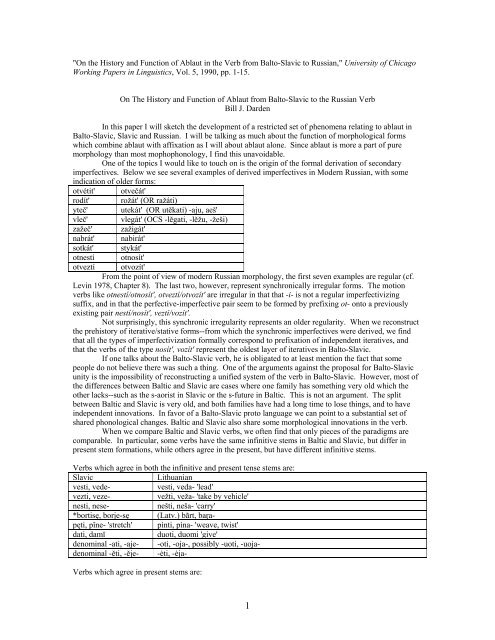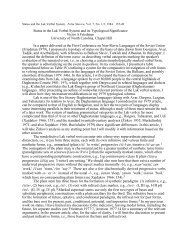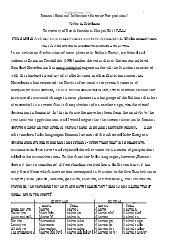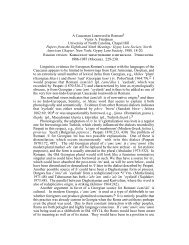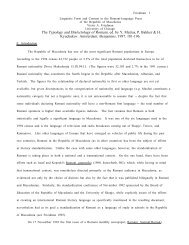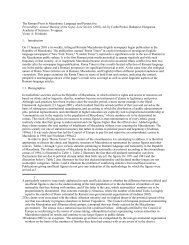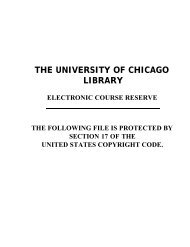"On the History and Function of Ablaut in the Verb from Balto-Slavic ...
"On the History and Function of Ablaut in the Verb from Balto-Slavic ...
"On the History and Function of Ablaut in the Verb from Balto-Slavic ...
Create successful ePaper yourself
Turn your PDF publications into a flip-book with our unique Google optimized e-Paper software.
"<strong>On</strong> <strong>the</strong> <strong>History</strong> <strong>and</strong> <strong>Function</strong> <strong>of</strong> <strong>Ablaut</strong> <strong>in</strong> <strong>the</strong> <strong>Verb</strong> <strong>from</strong> <strong>Balto</strong>-<strong>Slavic</strong> to Russian," University <strong>of</strong> Chicago<br />
Work<strong>in</strong>g Papers <strong>in</strong> L<strong>in</strong>guistics, Vol. 5, 1990, pp. 1-15.<br />
<strong>On</strong> The <strong>History</strong> <strong>and</strong> <strong>Function</strong> <strong>of</strong> <strong>Ablaut</strong> <strong>from</strong> <strong>Balto</strong>-<strong>Slavic</strong> to <strong>the</strong> Russian <strong>Verb</strong><br />
Bill J. Darden<br />
In this paper I will sketch <strong>the</strong> development <strong>of</strong> a restricted set <strong>of</strong> phenomena relat<strong>in</strong>g to ablaut <strong>in</strong><br />
<strong>Balto</strong>-<strong>Slavic</strong>, <strong>Slavic</strong> <strong>and</strong> Russian. I will be talk<strong>in</strong>g as much about <strong>the</strong> function <strong>of</strong> morphological forms<br />
which comb<strong>in</strong>e ablaut with affixation as I will about ablaut alone. S<strong>in</strong>ce ablaut is more a part <strong>of</strong> pure<br />
morphology than most mophophonology, I f<strong>in</strong>d this unavoidable.<br />
<strong>On</strong>e <strong>of</strong> <strong>the</strong> topics I would like to touch on is <strong>the</strong> orig<strong>in</strong> <strong>of</strong> <strong>the</strong> formal derivation <strong>of</strong> secondary<br />
imperfectives. Below we see several examples <strong>of</strong> derived imperfectives <strong>in</strong> Modern Russian, with some<br />
<strong>in</strong>dication <strong>of</strong> older forms:<br />
otvétit' otvečát'<br />
rodít' rožát' (OR ražáti)<br />
yteč' utekát' (OR utěkati) -aju, aeš'<br />
vleč' vlegát' (OCS -lěgati, -lěžu, -žeši)<br />
zažeč' zažigát'<br />
nabrát' nabirát'<br />
sotkát' stykát'<br />
otnestí<br />
otveztí<br />
otnosít'<br />
otvozít'<br />
From <strong>the</strong> po<strong>in</strong>t <strong>of</strong> view <strong>of</strong> modern Russian morphology, <strong>the</strong> first seven examples are regular (cf.<br />
Lev<strong>in</strong> 1978, Chapter 8). The last two, however, represent synchronically irregular forms. The motion<br />
verbs like otnestí/otnosít', otveztí/otvozít' are irregular <strong>in</strong> that that -i- is not a regular imperfectiviz<strong>in</strong>g<br />
suffix, <strong>and</strong> <strong>in</strong> that <strong>the</strong> perfective-imperfective pair seem to be formed by prefix<strong>in</strong>g ot- onto a previously<br />
exist<strong>in</strong>g pair nestí/nosít', veztí/vozít'.<br />
Not surpris<strong>in</strong>gly, this synchronic irregularity represents an older regularity. When we reconstruct<br />
<strong>the</strong> prehistory <strong>of</strong> iterative/stative forms--<strong>from</strong> which <strong>the</strong> synchronic imperfectives were derived, we f<strong>in</strong>d<br />
that all <strong>the</strong> types <strong>of</strong> imperfectivization formally correspond to prefixation <strong>of</strong> <strong>in</strong>dependent iteratives, <strong>and</strong><br />
that <strong>the</strong> verbs <strong>of</strong> <strong>the</strong> type nosít', vozít' represent <strong>the</strong> oldest layer <strong>of</strong> iteratives <strong>in</strong> <strong>Balto</strong>-<strong>Slavic</strong>.<br />
If one talks about <strong>the</strong> <strong>Balto</strong>-<strong>Slavic</strong> verb, he is obligated to at least mention <strong>the</strong> fact that some<br />
people do not believe <strong>the</strong>re was such a th<strong>in</strong>g. <strong>On</strong>e <strong>of</strong> <strong>the</strong> arguments aga<strong>in</strong>st <strong>the</strong> proposal for <strong>Balto</strong>-<strong>Slavic</strong><br />
unity is <strong>the</strong> impossibility <strong>of</strong> reconstruct<strong>in</strong>g a unified system <strong>of</strong> <strong>the</strong> verb <strong>in</strong> <strong>Balto</strong>-<strong>Slavic</strong>. However, most <strong>of</strong><br />
<strong>the</strong> differences between Baltic <strong>and</strong> <strong>Slavic</strong> are cases where one family has someth<strong>in</strong>g very old which <strong>the</strong><br />
o<strong>the</strong>r lacks--such as <strong>the</strong> s-aorist <strong>in</strong> <strong>Slavic</strong> or <strong>the</strong> s-future <strong>in</strong> Baltic. This is not an argument. The split<br />
between Baltic <strong>and</strong> <strong>Slavic</strong> is very old, <strong>and</strong> both families have had a long time to lose th<strong>in</strong>gs, <strong>and</strong> to have<br />
<strong>in</strong>dependent <strong>in</strong>novations. In favor <strong>of</strong> a <strong>Balto</strong>-<strong>Slavic</strong> proto language we can po<strong>in</strong>t to a substantial set <strong>of</strong><br />
shared phonological changes. Baltic <strong>and</strong> <strong>Slavic</strong> also share some morphological <strong>in</strong>novations <strong>in</strong> <strong>the</strong> verb.<br />
When we compare Baltic <strong>and</strong> <strong>Slavic</strong> verbs, we <strong>of</strong>ten f<strong>in</strong>d that only pieces <strong>of</strong> <strong>the</strong> paradigms are<br />
comparable. In particular, some verbs have <strong>the</strong> same <strong>in</strong>f<strong>in</strong>itive stems <strong>in</strong> Baltic <strong>and</strong> <strong>Slavic</strong>, but differ <strong>in</strong><br />
present stem formations, while o<strong>the</strong>rs agree <strong>in</strong> <strong>the</strong> present, but have different <strong>in</strong>f<strong>in</strong>itive stems.<br />
<strong>Verb</strong>s which agree <strong>in</strong> both <strong>the</strong> <strong>in</strong>f<strong>in</strong>itive <strong>and</strong> present tense stems are:<br />
<strong>Slavic</strong><br />
Lithuanian<br />
vesti, vede-<br />
vesti, veda- 'lead'<br />
vezti, veze-<br />
vežti, veža- 'take by vehicle'<br />
nesti, nese-<br />
nešti, neša- 'carry'<br />
*bortisę, borje-sę (Latv.) bãrt, baŗapęti,<br />
pĭne- 'stretch' pìnti, pìna- 'weave, twist'<br />
dati, damĭ<br />
duoti, duomi 'give'<br />
denom<strong>in</strong>al -ati, -aje- -oti, -oja-, possibly -uoti, -uojadenom<strong>in</strong>al<br />
-ěti, -ěje- -ėti, -ėja-<br />
<strong>Verb</strong>s which agree <strong>in</strong> present stems are:<br />
1
pĭsati, piše- 'write'<br />
rězati, rěže- 'cut'<br />
-zĭdati, -zižde- 'build'<br />
gŭnati, žene- 'drive'<br />
kováti, kuje- 'forge'<br />
-ovati, -uje-<br />
piešti, piešia- 'draw'<br />
rėžti, rėžia- 'cut'<br />
žiesti, žiedžia- 'make(<strong>from</strong> clay)'<br />
giñti, gena- 'drive'<br />
káuti, kauja- 'hit, forge'<br />
-auti, -auja-<br />
Two major classes <strong>of</strong> verbs agree <strong>in</strong> <strong>the</strong> <strong>in</strong>f<strong>in</strong>itive stem, but differ <strong>in</strong> <strong>the</strong> present formation. These are: (1)<br />
<strong>the</strong> causative/iteratives with <strong>in</strong>f<strong>in</strong>itives <strong>in</strong> -ī-, which have <strong>Slavic</strong> presents with -ī-, Baltic presents <strong>in</strong> -o-<br />
(*ā), <strong>and</strong> (2) stative/duratives with <strong>in</strong>f<strong>in</strong>itives <strong>in</strong> -ē-, which have <strong>Slavic</strong> presents <strong>in</strong> -ī-, Baltic presents <strong>in</strong><br />
short -i- or -a-. Examples <strong>of</strong> exact cognates are:<br />
broditi, broditŭ 'wade' bradyti, brado (dial)<br />
buditi 'wake up [tr.]'<br />
pa-si-baudyti 'get up [<strong>in</strong>tr.]'<br />
goniti 'drive'<br />
ganyti<br />
měniti 'change'<br />
ma<strong>in</strong>yti<br />
měsiti 'mix'<br />
maišyti<br />
prositi 'ask'<br />
prašyti<br />
bŭděti, bŭditŭ 'be awake' budėti, budi<br />
gorěti 'burn'<br />
garėti<br />
mĭněti 'th<strong>in</strong>k'<br />
m<strong>in</strong>ėti 'remember'<br />
smĭrděti 'st<strong>in</strong>k'<br />
smirdėti<br />
sěděti 'sit'<br />
sėdėti<br />
viděti 'see'<br />
pavydė´ ti 'envy'<br />
Latv. viẽdêt 'see', vîdêt 'envy; be <strong>in</strong> sight'<br />
kypěti, kypitŭ 'boil'<br />
kūpėti, kūpa 'boil, rise'<br />
Latv. kûpêt, kûpu 'smoke'<br />
svĭtěti 'sh<strong>in</strong>e'<br />
svitėti 'sh<strong>in</strong>e'<br />
The system which <strong>Balto</strong>-<strong>Slavic</strong> <strong>in</strong>herited <strong>from</strong> PIE <strong>in</strong>cluded <strong>the</strong> follow<strong>in</strong>g features:<br />
1) Primary a<strong>the</strong>matic verbs had alternations between zero-grade <strong>and</strong> e-grade ablaut. In <strong>the</strong><br />
present this <strong>in</strong>volved e-grade <strong>in</strong> <strong>the</strong> s<strong>in</strong>g., zero grade <strong>in</strong> <strong>the</strong> dual <strong>and</strong> plural.<br />
2) Primary verbs with <strong>the</strong>matic (-e/o-) <strong>in</strong>flection had ei<strong>the</strong>r e- or zero-grade, depend<strong>in</strong>g on <strong>the</strong><br />
accent.<br />
3) Derived iteratives/factitives had o-grade ablaut.<br />
4) Derived verbal nouns with o-stem <strong>in</strong>flection had o-grade ablaut.<br />
5) The sigmatic aorist had leng<strong>the</strong>ned grade. This is <strong>the</strong> only c<strong>and</strong>idate for common IE<br />
leng<strong>the</strong>ned grade <strong>in</strong> <strong>the</strong> verb.<br />
The alternations <strong>in</strong> a<strong>the</strong>matic verbs were elim<strong>in</strong>ated <strong>in</strong> <strong>Balto</strong>-<strong>Slavic</strong>.<br />
After <strong>the</strong> syllabic sonorants yielded short ĭ <strong>and</strong> ŭ plus sonorant, <strong>the</strong> ablaut system underwent a<br />
restructur<strong>in</strong>g. The f<strong>in</strong>al result was that, except for <strong>the</strong> true zero <strong>in</strong> alternations between *CeuC <strong>and</strong> *CuC, ĭ<br />
was <strong>the</strong> only rule-governed reduced grade ablaut. (In addition, Baltic developed an alternation ē / ī).<br />
There are a few cases <strong>of</strong> ŭ next to a sonorant (<strong>from</strong> a syllabic sonorant), such as <strong>Slavic</strong> gŭnati, žene- 'drive',<br />
compared to Lith g<strong>in</strong>ti, gena 'drive', but <strong>the</strong>se must be considered exceptional. <strong>On</strong>e can also f<strong>in</strong>d examples<br />
<strong>of</strong> true etymological zero grade, such as <strong>Slavic</strong> grěti 'heat', which must be related to gorěti 'burn'. This is<br />
not, however, a case <strong>of</strong> rule-governed ablaut. Gorěti, <strong>in</strong> fact, is <strong>in</strong> a stem shape where we would expect<br />
zero-grade. Whatever its source, gorěti had been re<strong>in</strong>terpreted as hav<strong>in</strong>g a basic -o-, which did not take a<br />
zero grade.<br />
This new i-grade which alternated with e-grade affected several verbal patterns <strong>in</strong> ways that are<br />
normally described as analogical departures <strong>from</strong> <strong>the</strong> regular behavior <strong>of</strong> syllabic sonorants. In <strong>the</strong> new<br />
system, alternations like OR bresti, brĭdu, pomereti, pomĭru are morphophonologically regular, even<br />
though <strong>the</strong> forms with ĭ are not phonologically regular developments <strong>from</strong> *b•d•, pom••. We even f<strong>in</strong>d ĭ<br />
for <strong>the</strong> zero grade between obstruents <strong>in</strong> *pĭzděti, Sln pëzdéti, R. bzdet' 'fart silently' (Lith bezdėti, Lat<strong>in</strong><br />
pēdere, (*pesdere), Gk bdéō), OR žeči, žĭgu 'burn' (Lith degti). In general, however, zero grade was not<br />
allowed between obstruents <strong>in</strong> <strong>the</strong> later languages.<br />
2
Ano<strong>the</strong>r <strong>of</strong> <strong>the</strong> major B-S <strong>in</strong>novations <strong>in</strong> ablaut was <strong>the</strong> development <strong>of</strong> leng<strong>the</strong>ned grade--<br />
<strong>in</strong>clud<strong>in</strong>g <strong>the</strong> leng<strong>the</strong>n<strong>in</strong>g <strong>of</strong> i or u <strong>in</strong>troduced next to syllabic sonorants. Kurylowicz (1968: 318-9)<br />
suggests that this leng<strong>the</strong>ned grade was <strong>in</strong>troduced <strong>in</strong>to verbal paradigms with <strong>the</strong> loss <strong>of</strong> laryngeals.<br />
Stems <strong>of</strong> <strong>the</strong> shape C(V)RH- (<strong>of</strong> which <strong>the</strong>re are a substantial number) developed alternations <strong>in</strong> Length.<br />
Before consonants <strong>the</strong> laryngeal leng<strong>the</strong>ned <strong>the</strong> preced<strong>in</strong>g syllabic (Cv:RC or CR:C > CīRC/CūRC).<br />
Before a vowel <strong>the</strong> laryngeal disappeared without leng<strong>the</strong>n<strong>in</strong>g (CVRV). This pattern, with length <strong>in</strong> closed<br />
syllables <strong>and</strong> shortness <strong>in</strong> open syllables, was hardly a natural distribution, <strong>and</strong> was a c<strong>and</strong>idate for<br />
morphologization.<br />
The long vowels were later shortened <strong>in</strong> closed syllables, leav<strong>in</strong>g acute <strong>in</strong>tonation as evidence <strong>of</strong><br />
<strong>the</strong> old length. A concrete example is Lith. gìnti, gìna 'defend' (C`<strong>in</strong>C <strong>in</strong>dicates acute <strong>in</strong>tonation on i or u<br />
diphthongs), OCS žęti, žĭn• (SC žȅti) 'cut'. The acute <strong>in</strong>tonation <strong>in</strong> <strong>the</strong> <strong>in</strong>f<strong>in</strong>itive <strong>in</strong>dicates old *gīnti<br />
opposed to present g<strong>in</strong>-e/o-.<br />
The consonantal end<strong>in</strong>gs which would have conditioned <strong>the</strong> leng<strong>the</strong>ned variant <strong>in</strong>cluded <strong>the</strong><br />
<strong>in</strong>f<strong>in</strong>itive, <strong>the</strong> s-future, <strong>the</strong> s-past, <strong>and</strong> <strong>the</strong> l-participles, <strong>in</strong>s<strong>of</strong>ar as <strong>the</strong>y existed <strong>in</strong> each language. Where<br />
stem variants occurred elsewhere <strong>in</strong> <strong>Balto</strong>-<strong>Slavic</strong>, <strong>the</strong>y generally opposed <strong>the</strong> present tense stem to <strong>the</strong> rest<br />
<strong>of</strong> <strong>the</strong> paradigm. Kuriłowicz suggests that this pattern provided <strong>the</strong> model for <strong>the</strong> spread <strong>of</strong> <strong>the</strong> new length<br />
to <strong>the</strong> entire nonpresent stem, <strong>in</strong>clud<strong>in</strong>g <strong>the</strong> prevocalic stem <strong>of</strong> <strong>the</strong> past <strong>in</strong> Lithuanian (e.g. gýnė). <strong>On</strong>e<br />
might even argue that <strong>the</strong> nonpresent stem was <strong>the</strong> basic variant. It thus became a logical c<strong>and</strong>idate for a<br />
stem to be used <strong>in</strong> derivation. The later shorten<strong>in</strong>g <strong>of</strong> diphthongs <strong>in</strong> closed syllables changed <strong>the</strong> system.<br />
Ins<strong>of</strong>ar as length had spread to positions before vowels <strong>and</strong> was preserved, it became <strong>in</strong>terpretable as a<br />
morphologically conditioned leng<strong>the</strong>n<strong>in</strong>g. It <strong>the</strong>n could spread with<strong>in</strong> morphological categories to forms<br />
which did not orig<strong>in</strong>ally have laryngeals.<br />
<strong>On</strong>e <strong>of</strong> <strong>the</strong> ma<strong>in</strong> areas <strong>of</strong> spread <strong>of</strong> <strong>the</strong> leng<strong>the</strong>ned grade <strong>in</strong> <strong>the</strong> verb was <strong>in</strong> <strong>the</strong> formation <strong>of</strong><br />
derived iteratives <strong>and</strong> statives. Lithuanian seems to preserve <strong>the</strong> most archaic system. The primary<br />
iteratives are still formed with o-grade vocalism with <strong>the</strong> suffix -ī- <strong>in</strong> <strong>the</strong> <strong>in</strong>f<strong>in</strong>itive stem. (-st-ī- is also<br />
productive). The word classes with leng<strong>the</strong>ned grade are peripheral <strong>in</strong> <strong>the</strong> system, form<strong>in</strong>g iteratives <strong>and</strong><br />
statives with special nuances. <strong>On</strong>e clear category is that <strong>of</strong> resultative statives, called durative <strong>in</strong> <strong>the</strong><br />
Academy Grammar (Ulvydas 1971: 15). The grammar (p. 24) also provides categories it calls 'dim<strong>in</strong>utive'<br />
<strong>and</strong> '<strong>in</strong>tensive' iterative. I will not attempt to def<strong>in</strong>e <strong>the</strong>se categories. Examples are:<br />
Resultative statives with <strong>in</strong>f<strong>in</strong>itives <strong>in</strong> -o- (*ā), <strong>and</strong> present tenses with -*ā-, or <strong>in</strong>f<strong>in</strong>itives <strong>in</strong> -*ē-, presents<br />
<strong>in</strong> -i-. These verbs show leng<strong>the</strong>ned zero grade, e is replaced by ī short a (*o,a) is unaffected.<br />
kýšoti, kýšo, kýšojo 'be stick<strong>in</strong>g out' < kìšti 'stick <strong>in</strong>to'<br />
tvýroti, tvýro, tvýrojo 'be attached, rema<strong>in</strong>' < tvérti, tveria 'attach'<br />
rýmoti 'lie propped up' < rémti, remia 'support'<br />
týsoti 'lie stretched out' < tiesti 'stretch'<br />
gḷūdoti 'lie hidden' < glausti, glaudžia 'press aga<strong>in</strong>st'<br />
karóti 'hang' < kárti, kãria, kóre 'hang'<br />
kyšė́ti, kỹši, kyšė́jo = kýšoti<br />
tysė́ti = týsoti<br />
glūdė́ti = gḷūdoti<br />
Iteratives (<strong>of</strong>ten '<strong>in</strong>tensive') <strong>in</strong> -auti or -•oti<br />
bū́bauti/ bū́buoti [<strong>in</strong>tens. iter] < baubti 'roar'.<br />
dūśauti/dūśuoti 'brea<strong>the</strong> heavily, sigh [iter]' < dus- <strong>in</strong> dùsteleti 'sigh'.<br />
pū́tauti/pūtḷoti 'brea<strong>the</strong> heavily, blow' < pūsti, pùčia, pūtė 'blow', pùsti, punta, puto 'swell'.<br />
rėḱauti/rýkauti/rėḱoti [<strong>in</strong>tens. iter.] < rėkti, rėkia, rėkė 'shout'.<br />
kvėpuóti 'brea<strong>the</strong>', kvėpti, kvepia '<strong>in</strong>hale'.<br />
Iteratives <strong>in</strong> -*jā-ti. These formations seem to have been orig<strong>in</strong>ally secondary iteratives with<br />
'dim<strong>in</strong>utive' mean<strong>in</strong>g, derived <strong>from</strong> <strong>the</strong> primary iteratives with o-grade <strong>in</strong> <strong>the</strong> root <strong>and</strong> <strong>the</strong> -ī- suffix. This<br />
3
suffix leaves -o- <strong>in</strong> an open syllable unaffected, but conditions an acute accent on a diphthongal root<br />
syllable. The dim<strong>in</strong>utive mean<strong>in</strong>g is largely gone, but Skardžius (1943: 517) <strong>of</strong>ten glosses <strong>the</strong> derivatives<br />
as synonymous with derivatives <strong>in</strong> -<strong>in</strong>ėti, which is <strong>the</strong> productive dim<strong>in</strong>utive iterative suffix <strong>in</strong> <strong>the</strong> modern<br />
language.<br />
There are examples <strong>of</strong> this suffix added directly to basic verbal stems, <strong>in</strong> which case we do f<strong>in</strong>d<br />
examples <strong>of</strong> leng<strong>the</strong>n<strong>in</strong>g. These are likely to be later formations, however:<br />
kámšioti < kamšýti, kam̃ šo < kim̃ šti 'pack'<br />
knáisioti < knaisýti < knisti 'burrow'<br />
lándžioti < l<strong>and</strong>ýti < lį̃sti, leñda<br />
mė́čioti < mė́tyti < mèsti 'throw'<br />
sagióti < sagýti < sègti 'button'<br />
ská<strong>in</strong>ioti/skynioti < skìnti, skìna, skýnė 'tear'<br />
mýnioti < mìnti, mìna, mýnė 'trample'<br />
stūḿioti rymoti, rėkti > rykauti may parallel formations like OCS naricati (*nōrīkātei),<br />
<strong>from</strong> -rek-, which may <strong>the</strong>n be as old or older than formations with e > ě.<br />
The Lithuanian formations are peripheral not only <strong>in</strong> that <strong>the</strong>y are less numerous than <strong>the</strong> verbs <strong>in</strong><br />
<strong>in</strong>f<strong>in</strong>itives <strong>in</strong> -ī-, but also <strong>in</strong> that verbs with leng<strong>the</strong>ned root vowels are not used to form iteratives <strong>from</strong><br />
prefixed verbs --as are <strong>the</strong> -ī- stems. The only secondary suffix which has become a productive iterative<br />
suffix with prefixed verbs is <strong>the</strong> suffix -joti (*jā-ti), which <strong>in</strong> its synchronically productive use does not<br />
leng<strong>the</strong>n.<br />
What <strong>Slavic</strong> did was make <strong>the</strong> peripheral formations part <strong>of</strong> <strong>the</strong> core derivational pattern. It also<br />
generalized <strong>the</strong> leng<strong>the</strong>n<strong>in</strong>g to <strong>in</strong>clude *o <strong>and</strong> *e, <strong>and</strong> <strong>in</strong> <strong>the</strong> course <strong>of</strong> attested history has fixed <strong>the</strong> accent<br />
on <strong>the</strong> suffix. Examples <strong>of</strong> parallel formations, some <strong>of</strong> which show older patterns with stem accent are:<br />
sḷšati (*slóusjāti) < Lith klausýti, klaũso 'listen', klùsti 'beg<strong>in</strong> to hear', paklùsti 'heed'<br />
R.voróčat', SC vracáti < vorotíti, vrátiti<br />
These are <strong>the</strong> only forms I have found which seem to show <strong>the</strong> metatonic acute on <strong>the</strong> root diphthong.<br />
This Baltic evidence, if considered <strong>Balto</strong>-<strong>Slavic</strong>, solves <strong>the</strong> problem <strong>of</strong> <strong>the</strong> root accent <strong>in</strong> slušati, s<strong>in</strong>ce this<br />
is clearly a short-diphthongal stem, which would be expected to have suffixal accent (viz paklùsti, OCS<br />
slŭšati <strong>in</strong> competition with slyšati, (Vaillant 1966: 389).<br />
R. slýšati, slyxáti (Uk slyxáty, slyšu)<br />
R. dyšát, dyšḷ, dýšiš, OCS dyxati, dyšu, Lith dūsė́ti<br />
R. sýpat' < suti, sŭpe-<br />
SC mȉcati < mŭknǫti<br />
R. týkat' (older) týčet Latv. tûkât. -ãju (Erdz)[iter] 'press'<br />
R. mětát' 'throw' Latv. mẽtât -ãju [iter] 'throw'.<br />
The <strong>Slavic</strong> forms like slyšati, dyšati clearly parallel <strong>the</strong> Lith. forms with <strong>in</strong>f<strong>in</strong>itives <strong>in</strong> -*ē-, present<br />
<strong>in</strong> -i-. It is hard to say for sure whe<strong>the</strong>r <strong>the</strong> <strong>Slavic</strong> forms with <strong>in</strong>f. <strong>in</strong> -ā-, present <strong>in</strong> -je- without <strong>the</strong> ā, come<br />
<strong>from</strong> <strong>the</strong> same source as <strong>the</strong> Baltic forms with <strong>in</strong>f. <strong>in</strong> -*ā-, present <strong>in</strong> -ā-. They may be parallel<br />
developments. They are both peculiarly deverbal patterns opposed to <strong>in</strong>flectional patterns with <strong>in</strong>f. <strong>in</strong> -*ā-,<br />
present <strong>in</strong> -*ā-j-e/o- which were probably orig<strong>in</strong>ally denom<strong>in</strong>al. The only direct cognate pairs l<strong>in</strong>k <strong>Slavic</strong><br />
with Latvian, <strong>and</strong> Latvian merged <strong>the</strong> -*ā-, -*ā- pattern with that <strong>of</strong> -*ā-, -*ājo-.<br />
4
Ultimately, derivatives <strong>in</strong> -ā-ti, -ā-je- replaced <strong>the</strong> pattern <strong>in</strong> -ā-ti, -je-. The length alternations, as<br />
we noted, spread to all four short vowels. After <strong>the</strong> Common <strong>Slavic</strong> changes <strong>in</strong> vowel quality, <strong>the</strong>se are<br />
realized as <strong>the</strong> follow<strong>in</strong>g alternations:<br />
short > long<br />
ĭ > i<br />
na-bĭrati > na-birati<br />
ŭ > y<br />
po-sŭlati > po-sylati<br />
e > ě<br />
u-gnesti (ugnet•) > u-gnětati<br />
o > a<br />
pro-bosti (-bod•) > probadati<br />
There are clear traces <strong>of</strong> <strong>of</strong> pattern <strong>of</strong> e > i, which, recalls <strong>the</strong> pattern e > ī found <strong>in</strong> Lithuanian:<br />
pro-greti (-greb•) > progribati/progrěbati<br />
na-rešti (-rek•) > naricati/narěkati<br />
<strong>On</strong>e key to <strong>the</strong> difference <strong>in</strong> development between Baltic <strong>and</strong> <strong>Slavic</strong> is <strong>in</strong> <strong>the</strong> fate <strong>of</strong> <strong>the</strong> -ī- stem<br />
verbs. In <strong>Slavic</strong> this was a mixed bag <strong>of</strong> iteratives, factitives, <strong>and</strong> denom<strong>in</strong>al verbs. This is probably <strong>the</strong><br />
orig<strong>in</strong>al state <strong>of</strong> affairs. Greek, Sanskrit, <strong>and</strong> Germanic have related classes which comb<strong>in</strong>e iteratives,<br />
factitives <strong>and</strong> denom<strong>in</strong>als (Szemerényi 1970: 254-5). S<strong>in</strong>ce deverbal nouns <strong>of</strong>ten had o-grade vocalism, it<br />
was easy to mix <strong>the</strong> patterns. A new verb derived <strong>from</strong> a deverbal noun looked like a deverbal formation,<br />
<strong>and</strong> vice versa. This was particularly true <strong>of</strong> <strong>the</strong> factitives, s<strong>in</strong>ce <strong>the</strong> denom<strong>in</strong>al i-stems were primarily<br />
transitive. Baltic solved this problem by shift<strong>in</strong>g <strong>the</strong> factitives <strong>and</strong> denom<strong>in</strong>als out <strong>of</strong> this class. They<br />
acquired <strong>the</strong> suffix -<strong>in</strong>- (Latvian -<strong>in</strong>ā-), which is possibly denom<strong>in</strong>al <strong>in</strong> orig<strong>in</strong> (Stang 1968:367-74). In<br />
<strong>Slavic</strong> <strong>the</strong> class rema<strong>in</strong>ed mixed, although <strong>the</strong> most numerous group <strong>of</strong> verbs <strong>in</strong> this class is <strong>the</strong><br />
denom<strong>in</strong>als. This made it easy for <strong>the</strong> dist<strong>in</strong>ctively iterative/durative formations with leng<strong>the</strong>ned grade to<br />
take over <strong>the</strong> function <strong>of</strong> <strong>the</strong> orig<strong>in</strong>al o-grade iteratives.<br />
<strong>On</strong>e might also mention <strong>the</strong> possibility <strong>of</strong> iconic appropriateness <strong>of</strong> leng<strong>the</strong>ned grade as a sign <strong>of</strong><br />
durativity. This may have played a role <strong>in</strong> <strong>the</strong> orig<strong>in</strong>al <strong>Balto</strong>-<strong>Slavic</strong> formations, <strong>and</strong> <strong>in</strong> <strong>the</strong>ir spread <strong>in</strong><br />
<strong>Slavic</strong>.<br />
In <strong>the</strong> motion verbs <strong>the</strong> orig<strong>in</strong>al iteratives <strong>in</strong> o-grade with -i- suffix were preserved--perhaps<br />
because <strong>the</strong>re was no factitive possible with motion verbs, perhaps because <strong>the</strong>se verbs acquired special<br />
functions. Where <strong>the</strong> orig<strong>in</strong>al iteratives were preserved, <strong>the</strong>y were used with prefixes to form newly<br />
derived imperfectives.<br />
Aside <strong>from</strong> <strong>the</strong> motion verbs, <strong>the</strong> verbs <strong>in</strong> -i- came to be treated as an <strong>in</strong>dependent class <strong>of</strong> verbs<br />
which were perfective when prefixed, <strong>and</strong> which took imperfectives <strong>in</strong> -*jā-ti, pres. -jā-je-. The<br />
imperfectivization <strong>and</strong> <strong>the</strong> leng<strong>the</strong>n<strong>in</strong>g <strong>in</strong> <strong>the</strong> imperfective was extended to <strong>in</strong>clude denom<strong>in</strong>al verbs (cf.<br />
OR novŭ 'new' > obŭnoviti 'renew' > imperfective obŭnavljati.)<br />
Inflectional <strong>Ablaut</strong><br />
In primary verbs, one <strong>of</strong> <strong>the</strong> surpris<strong>in</strong>g aspects <strong>of</strong> B-S ablaut is <strong>the</strong> fact that zero grade is much<br />
more common <strong>in</strong> <strong>the</strong> <strong>the</strong>matic present than it is <strong>in</strong> o<strong>the</strong>r IE languages. This is discussed <strong>in</strong> Vaillant (1966,<br />
III, 218-9). The distribution <strong>of</strong> zero-grade is different <strong>in</strong> <strong>Slavic</strong> <strong>and</strong> Baltic. In <strong>the</strong> earliest historically<br />
attested <strong>Slavic</strong>, <strong>the</strong>re is a fairly coherent system. Assum<strong>in</strong>g <strong>the</strong> e-grade to be basic, we can characterize <strong>the</strong><br />
stems with a possibility <strong>of</strong> zero grade (really an e ~ i alternation) as <strong>of</strong> <strong>the</strong> shape C(e)RC-, C(e)R-, <strong>and</strong><br />
CR(e)C-. Here R st<strong>and</strong>s for any sonorant. Two verbs <strong>of</strong> <strong>the</strong> shape r(e)C- also show traces <strong>of</strong> ablaut. This<br />
means that stems <strong>in</strong> long vowels or stems with primary -o- did not ablaut with<strong>in</strong> <strong>in</strong>flection 1 . For <strong>Slavic</strong> we<br />
must add several additional qualifications. Before consonants we cannot differentiate *eN <strong>from</strong> *iN<br />
(orig<strong>in</strong>al zero grade); both show up as OCS ę. Nor can we differentiate *e <strong>and</strong> *i before *j, s<strong>in</strong>ce e > i <strong>in</strong><br />
this environment. F<strong>in</strong>ally, <strong>the</strong>re is a strong tendency for stems with u not to ablaut. Given <strong>the</strong> isolated<br />
position <strong>of</strong> <strong>the</strong> *eu ~ u alternation <strong>in</strong> a system where <strong>the</strong> basic alternation is e ~ i, this is underst<strong>and</strong>able--<br />
particularly after *eu > *jou.<br />
In <strong>the</strong> oldest layer <strong>of</strong> <strong>the</strong> vocabulary, where we might speak <strong>of</strong> form<strong>in</strong>g stems <strong>from</strong> roots ra<strong>the</strong>r<br />
than deriv<strong>in</strong>g words <strong>from</strong> o<strong>the</strong>r words, we can make generalizations about <strong>the</strong> appearance <strong>of</strong> *zero (i) vs e-<br />
grade. In general, if we form <strong>the</strong> aorist/<strong>in</strong>f<strong>in</strong>itive stem by add<strong>in</strong>g a vocalic affix to an ablaut<strong>in</strong>g root, we<br />
expect zero-grade before <strong>the</strong> suffix. In <strong>the</strong> correspond<strong>in</strong>g present tense without <strong>the</strong> suffix, we expect e-<br />
grade with <strong>the</strong> <strong>the</strong>matic conjugations <strong>in</strong> -e/o- <strong>and</strong> j-e/o-, but no change <strong>of</strong> ablaut with presents <strong>in</strong> -n-e/o- or<br />
-ī-. Examples are:<br />
5
Inf<strong>in</strong>itive<br />
pĭsati < *pisātei<br />
bĭrati < biratei < b•rātei<br />
mĭněti < *m<strong>in</strong>ētei<br />
pĭxn•ti < *pixnontei<br />
Present<br />
piše- < *peisjeberemĭni-<br />
< *m<strong>in</strong>ī<br />
pĭxne- < *pixne-<br />
Exceptional lack <strong>of</strong> e-grade <strong>in</strong> <strong>the</strong> present is found <strong>in</strong> sŭsati, sŭse- 'suck', rŭvati, rŭve- 'tear', lŭgati, lŭže<br />
'lie', tŭkati, tŭče- 'weave', sŭlati, sŭlje- 'send', rŭzati, rŭže- 'neigh', all with root <strong>in</strong>ternal *u. A possible true<br />
exception is pĭxati, pĭše-, pĭxaje- 'shove, kick', which is not attested <strong>in</strong> early texts.<br />
<strong>Verb</strong>s with ablaut<strong>in</strong>g stems which take no suffix <strong>in</strong> <strong>the</strong> aorist/<strong>in</strong>f<strong>in</strong>itive stem generaly have<br />
presents with <strong>the</strong> <strong>the</strong>matic suffix -e/o-. These verbs have a pattern with e-grade <strong>in</strong> <strong>the</strong> <strong>in</strong>f<strong>in</strong>itive, sup<strong>in</strong>e,<br />
<strong>and</strong> <strong>the</strong> sigmatic aorist, while *i (ĭ) occurs <strong>in</strong> all o<strong>the</strong>r forms. In verbs <strong>of</strong> <strong>the</strong> shape C(e)RC <strong>the</strong> zero grade<br />
even occurs <strong>in</strong> <strong>the</strong> second <strong>and</strong> third s<strong>in</strong>g. aorist, which is based on <strong>the</strong> old asigmatic aorist (formally <strong>the</strong> IE<br />
imperfect.). Those with <strong>the</strong> pattern C(e)R- (all with r), have *e-grade <strong>in</strong> <strong>the</strong> second <strong>and</strong> third s<strong>in</strong>gular<br />
aorist <strong>in</strong> OCS. Examples are:<br />
<strong>in</strong>f<strong>in</strong>itive čisti (*keit-tei) cvisti (*kweit-tei) *merti (OCS mrěti)<br />
sup<strong>in</strong>e čistŭ cvistŭ *mertŭ<br />
s-aorist čisŭ cvisŭ *merxŭ(OCS mrěxŭ)<br />
pres. čĭte- cvĭte- mĭre-<br />
3 s<strong>in</strong>g aorist čĭte cvĭte mrě (OCS)/ mĭre (OR)<br />
l-participle čĭl- cvĭl- mĭrl- (OR)<br />
pap čĭtŭš- cvĭtŭš- mĭrŭš-<br />
It is normally assumed that <strong>in</strong> <strong>the</strong> 2nd <strong>and</strong> 3rd s<strong>in</strong>g. aorist OCS mrě (*mers, mert) is older than<br />
OR mĭre, which is paired with a clearly young 1st s<strong>in</strong>g mĭroxŭ, 1st pl. mĭroxomŭ, etc. However, it is easy<br />
to argue that PS had a mĭre parallel<strong>in</strong>g čĭte, cvĭte, <strong>and</strong> that OCS <strong>in</strong>novated. After meta<strong>the</strong>sis changed<br />
*merti, merxŭ to mrěti, mrěxŭ, OCS could have treated <strong>the</strong> <strong>in</strong>f./aorist as a vowel-f<strong>in</strong>al stem, for which 2nd<br />
3rd s<strong>in</strong>g. mrě would be regular (cf. grěti, grěxŭ, grě.).<br />
There are a few traces <strong>of</strong> e/ĭ alternations <strong>in</strong> stem which are not <strong>of</strong> <strong>the</strong> optimal shape. RVC- stems<br />
do not normally ablaut (vz. nesti, nese-, vesti, vede-, vezti, veze-), but <strong>the</strong> one (or two) stems with <strong>in</strong>itial r<br />
do show traces <strong>of</strong> zero grade <strong>in</strong> ĭ. This is clear for OR rĭče-, rĭkoxŭ, OCS rešti, reče- 'say'. Russian rtut'<br />
'mercury', Cz rtut', P rtę´c, can be related to Lith risti, rita 'roll'. These words are not normally connected<br />
to *ret- <strong>in</strong> OI rethim, with o-grade nouns <strong>in</strong> Lat<strong>in</strong> rotā 'wheel', Lith ratas 'wheel', but <strong>the</strong>y may well be<br />
related. The Lith deivatives with i-diphthongs such as raityti 'twist' may be secondary formations like<br />
braidyti <strong>from</strong> bristi, breda. OR žeči, žĭg• has a e/ĭ alternation between obstruents, which is extremely rare.<br />
The defective stem for 'go' has e-grade *ei- <strong>in</strong> <strong>the</strong> <strong>in</strong>f<strong>in</strong>itve iti, zero grade with a -d- suffix <strong>in</strong> present jĭde-,<br />
<strong>and</strong> šĭd- as a suppletive stem <strong>in</strong> participles (R. šël, šla, šedšij).<br />
Both <strong>of</strong> <strong>the</strong> <strong>Slavic</strong> patterns may have IE pedigrees.<br />
In Skt. <strong>the</strong> <strong>the</strong>matic aorist (without an augment) normally had <strong>the</strong> accent on <strong>the</strong> vocalic <strong>the</strong>me, <strong>and</strong><br />
zero grade <strong>of</strong> <strong>the</strong> root (Whitney 306). This can create ablaut <strong>and</strong> accentual oppositions between <strong>the</strong><br />
pres./imp. stem <strong>and</strong> <strong>the</strong> aorist, e.g. pres. bódhati (*béudeti), aorist budánta, 'be awake'. This is not a<br />
systematic pattern <strong>in</strong> Skt. Accord<strong>in</strong>g to Whitney (306) a large number <strong>of</strong> <strong>the</strong> aorists <strong>of</strong> this type are formed<br />
<strong>from</strong> roots which have end stress <strong>in</strong> <strong>the</strong> present as well. It is more systematic <strong>in</strong> Gk., where <strong>the</strong> opposition<br />
between pres/imp stem <strong>and</strong> second aorist stem is <strong>of</strong>ten impemented with e-grade <strong>in</strong> <strong>the</strong> pres, zero-grade <strong>in</strong><br />
<strong>the</strong> second aorist. Examples (Smyth 157-8) are; leipō I leave [pres], elipon [aorist]; feugō 'I flee' [pres],<br />
efugon [aorist].<br />
Lithuanian has a similar pattern <strong>in</strong> <strong>the</strong> C(e)RC stems, with e-grade <strong>in</strong> <strong>the</strong> present, zero grade <strong>in</strong> <strong>the</strong><br />
<strong>in</strong>f<strong>in</strong>itive/past tense stem, cf. likti, pres. leika (*leik-o), past liko 'leave', which is cognate with Gk leipō.<br />
Lithuanian has this pattern is verbs where <strong>Slavic</strong> has just <strong>the</strong> opposite. Examples:<br />
Lith. milžti, melža 'milk', Sln. mlěsti/molsti, molze- 'milk'.<br />
Lith. kirsti, kerta 'hit', OCS črěsti, črĭte- 'cut'.<br />
Lith. bristi, breda/brenda 'wade', OR bresti, brĭde- 'wade'.<br />
Lith. kirpti, kerpa ', OCS -črěti, -črpe-.<br />
<strong>On</strong>e might attempt to relate <strong>the</strong> above pattern <strong>in</strong> Lithuanian <strong>and</strong> <strong>in</strong> Greek to <strong>the</strong> <strong>Slavic</strong> pattern<br />
mentioned before, with e-grade <strong>in</strong> <strong>the</strong> present <strong>and</strong> zero-grade <strong>in</strong> <strong>the</strong> aorist/<strong>in</strong>f<strong>in</strong>itive (ber•, bĭrati 'carry';<br />
6
piš•, pĭsati 'write'). As noted, however, <strong>the</strong> <strong>Slavic</strong> zero grade <strong>in</strong> <strong>the</strong>se forms is always associated with<br />
suffixation. It may have its own history.<br />
The unsuffixed stems like čisti, mrěti differ <strong>in</strong> oppos<strong>in</strong>g <strong>the</strong> apparent e-grade <strong>in</strong> <strong>the</strong> s-aorist <strong>and</strong><br />
<strong>in</strong>f<strong>in</strong>ite/sup<strong>in</strong>e to zero grade elsewhere. If we assume that <strong>the</strong> <strong>in</strong>f<strong>in</strong>itive <strong>and</strong> sup<strong>in</strong>e are formed <strong>from</strong> <strong>the</strong><br />
stem <strong>of</strong> <strong>the</strong> s-aorist, we have a near parallel to alternations which existed <strong>in</strong> Skt. when a root which formed<br />
a present tense stem with end stress had an s-aorist. Examples are Skt. pres. muc´ati, aorist a-māuk(s)<br />
'loose', pres. srjati, aorist a-srāk(s) 'pour out.' The Skt. aorist forms reflect long *ē <strong>in</strong> <strong>the</strong> root. We f<strong>in</strong>d<br />
overt long vowels <strong>in</strong> <strong>the</strong> sigmatic aorists <strong>of</strong> CVC stems <strong>in</strong> OCS (nesti, něsŭ, rešti, rěxŭ, bosti basŭ). S<strong>in</strong>ce<br />
<strong>the</strong>se s-aorists differ <strong>from</strong> <strong>the</strong> <strong>in</strong>f<strong>in</strong>itives (which have short vowels) we might doubt that <strong>the</strong> vocalism <strong>of</strong><br />
<strong>the</strong> <strong>in</strong>f<strong>in</strong>itive comes <strong>from</strong> <strong>the</strong> aorist. We <strong>the</strong>n have <strong>the</strong> possibility <strong>of</strong> three vowel grades <strong>in</strong> <strong>the</strong>se patterns: ē<br />
<strong>in</strong> <strong>the</strong> s-aorist, e <strong>in</strong> <strong>the</strong> <strong>in</strong>f<strong>in</strong>itive <strong>and</strong> sup<strong>in</strong>e, zero elsewhere. <strong>Slavic</strong> forms with diphthongs are ambiguous<br />
as to orig<strong>in</strong>al length <strong>of</strong> <strong>the</strong> e, s<strong>in</strong>ce <strong>Slavic</strong> merges long <strong>and</strong> short diphthongs. The lack <strong>of</strong> acute <strong>in</strong>tonation<br />
<strong>in</strong> <strong>Slavic</strong> (SC mrij`eti <strong>in</strong>dicates *mrětí) could be taken to <strong>in</strong>dicate a short vowel, but this is not diagnostic.<br />
The synchronic aorist <strong>in</strong> S.C. mr•jex also <strong>in</strong>dicates old end stress, ra<strong>the</strong>r than acute. Vaillant suggests<br />
that <strong>the</strong> e-grade <strong>of</strong> <strong>the</strong> <strong>in</strong>f<strong>in</strong>itive comes <strong>from</strong> <strong>the</strong> sup<strong>in</strong>e, which--if it is <strong>the</strong> parallel descendant <strong>of</strong> <strong>the</strong> verbal<br />
nouns <strong>in</strong> -tum found <strong>in</strong> Skt.--had simple e-grade vocalism.<br />
Vaillant assumes that <strong>the</strong> Lithuanian pattern <strong>in</strong> <strong>the</strong> unsuffixed verbs (like kirsti, kerta) is older<br />
than that <strong>of</strong> <strong>Slavic</strong>. He assumes orig<strong>in</strong>al e-grade <strong>in</strong> <strong>the</strong> <strong>the</strong>matic present, <strong>and</strong> attributes <strong>the</strong> development <strong>of</strong><br />
<strong>the</strong> <strong>in</strong>novative zero grade to <strong>the</strong> fact that <strong>Slavic</strong> generalized end stress <strong>in</strong> <strong>the</strong> present <strong>in</strong> this category. The<br />
e-grade <strong>in</strong> <strong>the</strong> sup<strong>in</strong>e <strong>and</strong> ē <strong>in</strong> <strong>the</strong> s-aorist he assumes to be orig<strong>in</strong>al.<br />
Without totally reject<strong>in</strong>g <strong>the</strong> possibility <strong>of</strong> <strong>the</strong> <strong>in</strong>fluence <strong>of</strong> stress, we should note that one cannot<br />
propose a sound change that would accomplish this--at least not one that would work outside <strong>of</strong> this class<br />
<strong>of</strong> verbs. As far as we can tell beréši had <strong>the</strong> same accent as mĭréši, <strong>and</strong> <strong>the</strong>re are plenty <strong>of</strong> o<strong>the</strong>r examples<br />
<strong>of</strong> unstressed e which did not go to ĭ. S<strong>in</strong>ce <strong>the</strong> motivation must be at least <strong>in</strong> part morphological, it may<br />
be primarily morphological. The opposition between e-grade <strong>in</strong> <strong>the</strong> present with zero-grade <strong>in</strong> <strong>the</strong> aorist<br />
applies to Greek <strong>and</strong> Sanskrit stems with <strong>the</strong>matic aorists, not s-aorists. After <strong>the</strong> neutralization <strong>of</strong> length<br />
<strong>in</strong> diphthongs, <strong>the</strong> <strong>Slavic</strong> sigmatic aorists <strong>of</strong> ablautable stems no longer had long ē. Synchronically <strong>the</strong>y<br />
had e-grade vocalism. The <strong>Slavic</strong> presents which disagree with Baltic <strong>in</strong> hav<strong>in</strong>g zero grade are precisely<br />
<strong>the</strong> class which allowed s-aorists. The zero grade <strong>in</strong> <strong>the</strong> present, even if admittedly a <strong>Slavic</strong> <strong>in</strong>novation,<br />
may have developed <strong>in</strong> opposition to <strong>the</strong> vocalism <strong>of</strong> <strong>the</strong> aorist. Baltic, which lost or did not have <strong>the</strong> s-<br />
aorist, elim<strong>in</strong>ated <strong>the</strong> possibility <strong>of</strong> such an opposition.<br />
The subsequent history <strong>of</strong> <strong>Slavic</strong> shows cont<strong>in</strong>uous loss <strong>of</strong> ablaut patterns. Most <strong>of</strong> <strong>the</strong> ablaut<br />
with<strong>in</strong> a s<strong>in</strong>gle <strong>in</strong>flection has been elim<strong>in</strong>ated. The process had actually started <strong>in</strong> prehistory, but is almost<br />
complete. Alternations like brat', beru; zvat', zovu; umeret', umru are clearly exceptional <strong>in</strong> Modern<br />
Russian. <strong>Verb</strong>s like bljusti, budit', bdet' are not even exceptional. They are not synchronicaly related.<br />
Aside <strong>from</strong> morphophonemically predictable vowel-zero alternations, <strong>the</strong> sole area <strong>of</strong> productive vowel<br />
alternations <strong>in</strong> <strong>the</strong> verb is <strong>in</strong> <strong>the</strong> formation <strong>of</strong> imperfectives. Even this has been restricted. The o > a<br />
alternation rema<strong>in</strong>ed productive, <strong>and</strong> was extended to <strong>the</strong> imperfectives formed with <strong>the</strong> relatively young<br />
suffix -yva-, <strong>and</strong> is applied to <strong>the</strong> purely East <strong>Slavic</strong> -o- <strong>in</strong> pleophonic forms <strong>from</strong> liquid diphthongs (e.g.<br />
*gord- > gorodŭ 'town' > (derived verb) zagoroditi > (imp.) zagoráživati). No trace <strong>of</strong> <strong>the</strong> e > ě alternation<br />
survives <strong>in</strong> Mordern Russian, although it survives <strong>in</strong> Ukra<strong>in</strong>ian as e > i. (MR zagresti (-grebu) > zagrebat',<br />
U zahrebsti, zahribati). The loss <strong>in</strong> Russian is probably due to <strong>the</strong> early merger <strong>of</strong> e <strong>and</strong> ě <strong>in</strong> unstressed<br />
position. In modern Russian o <strong>and</strong> a merge <strong>in</strong> unstressed position, <strong>and</strong> <strong>the</strong> o > a alternation <strong>in</strong> this position<br />
is no longer reflected <strong>in</strong> <strong>the</strong> spell<strong>in</strong>g (obnovit' > obnovlját' /abnavl'át'/).<br />
<strong>On</strong>e can argue that even where ablaut has been preserved, as <strong>in</strong> <strong>the</strong> case <strong>of</strong> derived imperfectives,<br />
it has changed its nature. Morphologically, <strong>the</strong>re are at least two ways <strong>of</strong> treat<strong>in</strong>g ablaut<strong>in</strong>g systems. We<br />
can treat a system like IE as hav<strong>in</strong>g a rich set <strong>of</strong> morphophonological rules which change vocalism, or we<br />
can use a system <strong>of</strong> nonconcatenative morphology like McCarthy (1981) has suggested for Semitic. In <strong>the</strong><br />
case <strong>of</strong> <strong>the</strong> history <strong>of</strong> <strong>Slavic</strong>, or specifically Russian, we see a very clear evolution away <strong>from</strong> a system<br />
which might have been described with nonconcatenative morphology <strong>in</strong>to a system which is best described<br />
with stems, affixes, <strong>and</strong> MP rules. The total elim<strong>in</strong>ation <strong>of</strong> vowel alternations ra<strong>the</strong>r obviously elim<strong>in</strong>ates<br />
<strong>the</strong> necessity <strong>of</strong> nonconcatenative morphology. The alternations which formed iteratives were historically<br />
based on ablaut<strong>in</strong>g root variants, <strong>and</strong> might at one time have been considered morphologically <strong>in</strong>dependent<br />
vowel 'morphemes' spelled out <strong>in</strong> CV skeleta. However, as anyone who has read anyth<strong>in</strong>g about<br />
synchronic imperfectivization knows, <strong>in</strong> <strong>the</strong> modern system <strong>the</strong> form <strong>of</strong> <strong>the</strong> imperfective is determ<strong>in</strong>ed<br />
<strong>from</strong> <strong>the</strong> shape <strong>of</strong> <strong>the</strong> perfective stem--not <strong>from</strong> <strong>the</strong> root (cf Lev<strong>in</strong> 1978, Chaper 8). If <strong>the</strong> perfective stem<br />
7
is <strong>the</strong> <strong>in</strong>put to <strong>the</strong> process, we are unambiguously deal<strong>in</strong>g with a stem-affix<strong>in</strong>g system, with MP rules<br />
which change <strong>the</strong> vowels.<br />
The same is true <strong>of</strong> deverbal noun formation, which was <strong>the</strong> last bastion <strong>of</strong> o-grade ablaut. We<br />
can see a clear pattern <strong>of</strong> evolution <strong>in</strong> <strong>the</strong> formation <strong>of</strong> deverbal nouns which is elim<strong>in</strong>at<strong>in</strong>g abstract o-<br />
grade ablaut <strong>in</strong> favor <strong>of</strong> derivation by truncation <strong>from</strong> one <strong>of</strong> <strong>the</strong> forms <strong>of</strong> <strong>the</strong> verbal stem. Forms like upëk<br />
(<strong>from</strong> upekat', upeč'), zatëk (<strong>from</strong> zatekat', zateč') have replaced older formations with -o-. Prizyv, zazyv<br />
represent more productive formations than výzov <strong>from</strong> -zvat', -zyvat'. forms like ybirka (ubirat', ubrat')<br />
obdirka (obdirat', obodrat') are legitimate competitors for formations like uborka <strong>and</strong> razdor. We f<strong>in</strong>d<br />
absolutely stable derivatives <strong>in</strong> o-grade only where we have irregular imperfectives with o-grade, as <strong>in</strong><br />
unos (unosit', unesti), uvoz (uvozit' uvesti), uxod (uxodit' ujti). For <strong>the</strong>se forms we do not have to propose<br />
ablaut <strong>in</strong> <strong>the</strong> noun formation itself. The o-grade is already <strong>in</strong> <strong>the</strong> verb. Forms like unos are synchronically<br />
parallel to prizyv <strong>and</strong> ubirka--formally derived <strong>from</strong> <strong>the</strong> imperfective verb by truncation (truncation plus<br />
affixation <strong>in</strong> <strong>the</strong> case <strong>of</strong> ubirka.).<br />
The process <strong>of</strong> shift<strong>in</strong>g <strong>from</strong> an ablaut<strong>in</strong>g system to a stem-affix<strong>in</strong>g system started <strong>in</strong> prehistory,<br />
although <strong>the</strong> older system was fairly clear at <strong>the</strong> time <strong>of</strong> <strong>the</strong> first attested language. This k<strong>in</strong>d <strong>of</strong> change is<br />
always possible. Stem-affix derivation has advantages <strong>in</strong> transparency over ablaut<strong>in</strong>g derivation. Even<br />
Lithuanian shows some tendencies to replace ablaut<strong>in</strong>g patterns by transparent affixation. Never<strong>the</strong>less,<br />
we would like to f<strong>in</strong>d some reason for <strong>the</strong> drastic change <strong>in</strong> mophological type which took place <strong>in</strong> <strong>Slavic</strong>,<br />
<strong>and</strong> for <strong>the</strong> fact that it started so early, compared to Baltic. The most obvious c<strong>and</strong>idate for <strong>the</strong> set <strong>of</strong><br />
changes which <strong>in</strong>itiated this process were <strong>the</strong> changes which elim<strong>in</strong>ated <strong>the</strong> diphthongs <strong>in</strong> <strong>Slavic</strong>. This<br />
rendered <strong>in</strong>coherent <strong>the</strong> old ablaut system, which had been most clear <strong>in</strong> diphthongal stems. We can see <strong>the</strong><br />
effects <strong>in</strong> <strong>the</strong> follow<strong>in</strong>g table.<br />
IE Late Common <strong>Slavic</strong> OR<br />
-ei- ī i<br />
-oi- ǣ ė<br />
-i- ĭ ĭ<br />
-eu- jū ju<br />
-ou- ū u<br />
-u- ŭ ŭ<br />
-nḶ- ę (ǫ) æ (u)<br />
-en- ę æ<br />
-on- ǫ u<br />
-ḷ- ĭl (ŭl) ŭl<br />
-el- -el- olo<br />
-ol- -ol- olo<br />
-ṛ- ĭr (ŭr) ĭr (ŭr)<br />
-er- -er- ere<br />
-or- -or- oro<br />
These changes <strong>in</strong> diphthongs were probably completed only shortly before <strong>the</strong> appearance <strong>of</strong><br />
written texts. The historical period has been a long period <strong>of</strong> adjustment <strong>of</strong> <strong>the</strong> system, repair<strong>in</strong>g <strong>the</strong><br />
damage done by <strong>the</strong> phonology.<br />
1) We must assume that zŭvati, zove- 'call' represents an *e/zero alternation, with *e > o before w. In this<br />
case at least, however, we have a zero grade <strong>of</strong> ŭ correspond<strong>in</strong>g to a full grade with is synchronic o.<br />
Bibliography<br />
Fasmer, M. 1964-1973, `Etimologičeskij slovar' russkogo jazyka, Moscow: Progress.<br />
Kaga<strong>in</strong>e, E., 1977-83, Er´gemes izloksnes vārdnīca, Riga: Z<strong>in</strong>ātne<br />
Kruopas, J. et al., 1972, Dabart<strong>in</strong>ės lietuvių kalbos žodynas, Vilnius: M<strong>in</strong>tis.<br />
Lev<strong>in</strong>, M. I., 1978, Russian Declension <strong>and</strong> Conjugation, Columbus: <strong>Slavic</strong>a.<br />
8
McCarthy, J.J., 1981, "A Prosodic Theory <strong>of</strong> Nonconcatenative Morphology," L<strong>in</strong>guistic Inquiry 12: 373-<br />
418.<br />
Mühlenbach, K., 1923-32, Lettisch-deutsches Wörterbuch, Riga: Kultūras fondas.<br />
Sadnik, L., <strong>and</strong> R. Aitzetmüller, 1955, H<strong>and</strong>wörterbuch zu den altkirchenslavischen Texten, 'S-<br />
Gravenhage: Mouton.<br />
Skardžius, P., 1943, Lietuvių kalbos žodžių daryba, Vilnius: Lietuvos Mokslų Akademia.<br />
Smyth, Herbert Weir, 1956, Greek Grammar. Cambridge: Harvard University Press.<br />
Stang, C. S.,1942, Das slavische und baltische <strong>Verb</strong>um, Oslo: I Kommisjon Hos Jacob Dybwad.<br />
______ , 1968, Vergleichende Grammatik der baltischen Sprachen, Oslo: Universitetsforlaget.<br />
Szemerényi, O., 1970, E<strong>in</strong>fürung <strong>in</strong> die vergleichende Sprachwissenschaft, Darmstadt: Wissenschaftliche<br />
Buchgesellschaft.<br />
Ulvydas, E., et al. 1971, Lietuvių kalbos gramatika, Vol II, Vilnius: M<strong>in</strong>tis.<br />
Vaillant, André, 1966, Grammaire comparée des langues slaves, Vol. III, Paris: Kl<strong>in</strong>cksieck.<br />
Vasmer = Fasmer<br />
Whitney, Wm. D., 1981, Sanskrit Grammar (repr<strong>in</strong>t <strong>of</strong> 1889 edition), Cambridge: Harvard University<br />
Press.<br />
9


